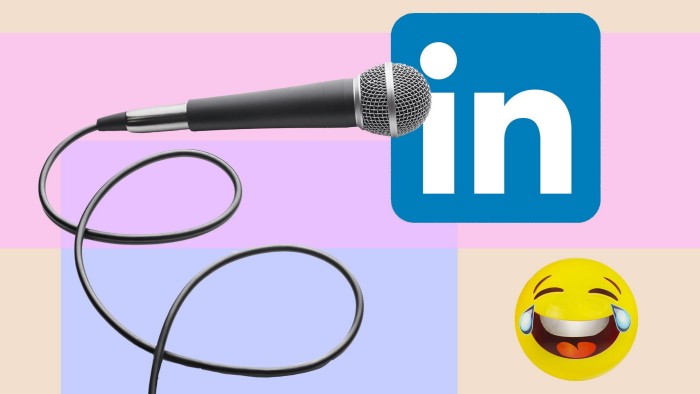Unlock the Editor’s Digest for free
Roula Khalaf, Editor of the FT, selects her favourite stories in this weekly newsletter.
When British creative director Rob Mayhew was scrolling through LinkedIn back in 2020, his feed was devoid of funny content. The professional social network was primarily used to find a job and for ostensibly humble, yet often cringeworthy, bragging about personal achievements.
“It’s not where you go to laugh,” says Mayhew, who saw humour as an opportunity to differentiate himself on a site filled with corporate platitudes and seriousness. He has posted hundreds of sketches about shared work experiences such as being stuck in a Zoom waiting room, increasing his following to more than 128,000.
As personal and professional lives have blurred following the pandemic, the content individuals and companies post on LinkedIn has changed. Personal posts about low points and vulnerabilities have gone viral. But so has content that makes fun of corporate life, riffs on working from home and raps about being an IT salesman.
“We’re tired of corporate jargon, business insights and leadership ramblings,” says Charlotte Day, director at social media consultancy Contentworks Agency. In a sea of online advertisements, humour is increasingly being used as a strategy to “break through monotony” and connect in a more informal way.
Comedy-focused “LinkedInfluencers” include Corporate Natalie, whose videos to 140,000 followers poke fun at everything from Gen Z vaping in conference rooms to the irresponsible new hire you should not take on a Las Vegas work trip.
Between 2019 and 2022, LinkedIn recorded a 160 per cent increase in “members requesting more ways to express humour”. The use of phrases such as “haha”, “lol”, and humour-related emojis in comments also nearly doubled, prompting the addition of a laughing emoji to the platform’s standard set of five reactions. US comedian Mindy Kaling announced the news, encouraging users to post “hilarious work interactions” on the site.
The shift to be more light-hearted comes as LinkedIn’s popularity is growing rapidly.
Yet the humorous potential of the site is complicated by its reputation for “accidental comedy”: outlandish posts bragging about punishing routines, or gleaning business lessons from unspeakable tragedies with absurd sincerity. Entire Reddit threads are dedicated to exposing the worst examples of self-promotion or overwork. Parody accounts skewering tone-deaf posts of hyper-ambitious leaders have tens of thousands of followers. At times, it becomes difficult to distinguish between genuine and satirical content.
Gyanda Sachdeva, head of LinkedIn consumer experience, says it is now more common to find humour in posts, especially in video, which lends itself well to “more relatable” content. The platform last year launched a TikTok-style video feed on mobile devices.
However Sachdeva stresses “humour is not the end game at all”, and should be used as a “means to an end” on a social network made for people to exchange professional knowledge. “If humour is a good way to do that, fantastic.”
For some companies, using snarky posts to pursue marketing goals comes easily. Digital bank Monzo runs “mundane polls” about office small talk, while marketing platform Semrush likens digital marketers to contestants on dystopian thriller Squid Game.
Even Blackstone, the world’s largest private equity firm, plays for laughs. It has created holiday videos since 2018, including a riff on Taylor Swift’s Eras Tour filled with finance jokes. Christine Anderson, Blackstone’s head of global corporate affairs, says the videos challenge a “presumption” finance workers are serious. “We are trying to show that our people are mission driven, but also authentic and great colleagues that enjoy working together.”
Mayhew, who describes his content as “holding a mirror up to the ridiculousness of most of our jobs”, would love to see more humour on the site, but adds there is a fine line between funny and cringeworthy.
Given the high number of “laughing” emojis in response to Blackstone’s posts, the company appears to be walking the right side of that divide.
Read the full article here

